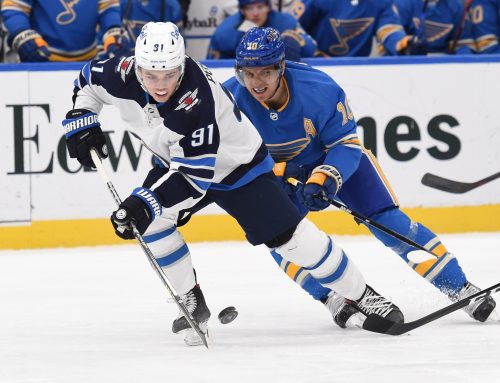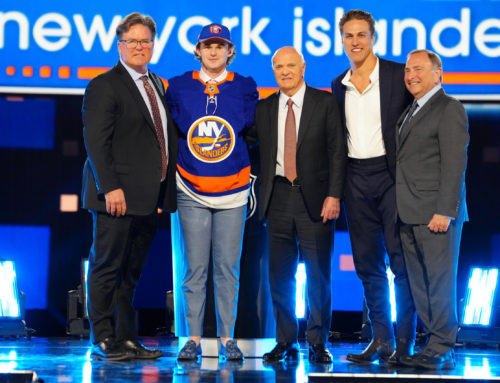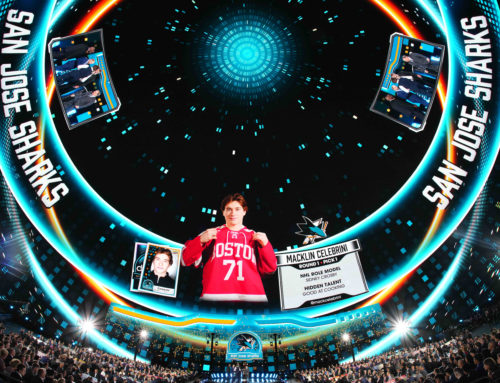The Journey: Why You Should Trade First-Round Farm Picks
Ben Gehrels
2023-12-09
Welcome back to The Journey, where we track the development of prospects as they excel in junior, make the NHL, and push towards stardom.
Although it might seem strange for a column dedicated to highlighting the world's best up-and-coming prospects, I am going to argue this week that fantasy managers will generally recoup more value from trading their first-round farm picks than hanging onto them. Unless there is a Connor Bedard at play, you should maybe even consider trading that sweet, sweet first overall pick. Bear with me.
*****
The World Juniors provides an annual reminder that fantasy hockey is like a stock market. Some players excel and gain value while others fail to impress, leaving their fantasy owners questioning the long-term security of their asset. Spin-off fantasy games like Dobbernomics, where you attempt to constantly buy low and sell high before the rest of the players catch on to shifts in value, are explicitly based on that premise. But regular fantasy works that way too.
As a result, we are reading our opponents in each league just as much as the players and prospects themselves. If someone in my league thinks that a certain prospect is at a certain level, that is really all that matters. If they already own that player, it will likely be too expensive to pry him away. But if they are after my player, I have an opportunity to gain value for my team by flipping him.
If you are paying attention and keeping track (ie. via spreadsheet), it is relatively easy to develop a feel for which type of players have particular value in a given league. Or to track how specific managers in your league tend to construct their rosters: Tom's favourite team is the Rangers, for instance, and I notice that he consistently pays a premium to acquire top New York players. Ashley always cites the Dobber top prospect rankings, so I know that's how she generally values prospects. Darren aims to stack linemates. Jared wants to own all the best prospect goalies. And so on.
After all, not everyone plays fantasy hockey to win. I wrote back in August about cognitive biases that commonly affect poolies' decisions, including impatience, gathering homer picks, bad decisions, tinkering addiction, collecting specific players, and ignoring key context indicators.
Most of us play to win, but most of us also play to play.
The thing about prospects is that they are SO MUCH FUN to draft and hoard. It is exhilarating to grab a slice of the next big thing in fantasy, to discover and exploit gaps in value and knowledge. But how efficient is it actually to build a team through the draft?
A friend of mine recently accepted a trade that got me thinking further along these lines. He moved Easton Cowan (TOR) and a third-round pick for Arthur Kaliyev (LAK) and a fourth. Which side would you take?

Cowan, a surprise first-rounder by the Leafs last year, is in the midst of a very impressive Draft+1 campaign, currently sporting 39 points in only 23 games. Meanwhile, Kaliyev, 22, is on a 47-point pace with the Kings.
Leafs fans might prefer the Cowan side because he is the Shiny New Toy in their pipeline. And fresh prospects get a noticeable value boost in many circles because their upside is more of an alluring question mark than more established players, who are sometimes viewed as damaged goods or lost causes.
In my books, though, the Kaliyev side won this trade handily simply due to timeline. Cowan is likely looking at either another year in junior after this one, followed by a couple years in the AHL. Then he'll have to crack the Leafs, which is a tall order in itself. Just ask 22-year-old Nick Robertson, who destroyed the OHL in his D+1 to the tune of 55 goals in 46 games, only to spend the next four years (including 2023-24) trying to establish himself in the NHL. He's labouring on the third line this year and has rewarded his patient owners with seven points in 12 games so far.
The point is that it could easily be four, five, six years until Cowan is having a meaningful impact in fantasy. Not only does he need to jump all the hurdles described above (2-3 years); he also needs to reach his 200-game Breakout Threshold once he does make the show for good, which is another 2.5 – 3 years.
While none of this is a secret, I feel like it is a lesson that many fantasy managers wilfully ignore and consistently forget. Because it's more fun if prospects make the NHL and start contributing right away, right? Maybe it will happen this time! Maybe Devon Levi will seize the starter's reins at age 21 directly out of college! Maybe, but probably not. This is a lesson that projection models teach us: pessimism and patience.
Kaliyev, on the other hand, is pushing 50 points in the NHL at age 22 with under 14 minutes of ice time per game. And the best part is that he is only 33 games away from hitting 200 NHL games in his career. He is scoring in the NHL now, and there is a ton of room for growth still.
The longer I play in keeper and dynasty formats, the more cynical I feel about strategies based on hoarding picks and prospects. It just takes too long! This is a point I remember Elan (from Keeping Karlsson) making in one of our league chats years ago: Always go for the win because realistically many leagues fall apart. If a league folds after three years, and we are talking about 5–6-year timelines for most prospects between being drafted and hitting their NHL upside, that math just does not check out.
While building from the draft certainly makes sense with Bedard-level talent, I suspect that there is often more value to be gained from trading first round picks versus keeping them. And players like Kaliyev, post-hype prospects who have played 100 or so NHL games, are increasingly becoming my favourite targets with those picks.
It might be cherry picking to some extent, but Alexis Lafreniere (NYR) is an interesting example. He is on a 52-point pace this year and seems to finally be rounding into form, but it has been a four-year wait since he was taken first overall back in 2020. If you were savvy enough to flip that first-overall pick back then for a high-end-to-elite post-hype prospect who was 100-150 games into his NHL career, you would probably have received terrific production these past four years instead of sitting on a disappointing player who is finally providing replacement-level production 240 games into his career.
No one wants to trade that pick, though, because that's not fun. Drafting is the best part of fantasy. So trading top picks ahead of a new draft can be a grim experience. The other difficult part is that it can be nerve wracking to buy low on players who have not done a whole lot yet at the NHL level. Their junior accolades are a distant memory, and it is very possible that they could be a bust at the NHL level—at least compared to what they were expected to become at the draft.
Other recent examples include Marco Rossi (MIN), Lucas Raymond (DET), Alexander Holtz (NJD), and Quinton Byfield (LAK). These players represent five of the top ten prospects taken in the top ten back in 2020, and they are all finally starting to return decent value only several years later. And most of them still have multiple seasons to play before we should expect to see their ultimate upside.
Combing through draft lists from 2-4 years ago can be a very productive exercise when searching for potential trade targets for your high-end farm picks. Other intriguing names from that first round in 2020: Dawson Mercer (NJD), Lukas Reichel (CHI), Anton Lundell (FLA), Tyson Foerster (PHI), Connor Zary (CGY), Jake Neighbours (STL), Mavrik Bourque (DAL), Ridly Greig (OTT).
2019: Alex Newhook (MTL), Cam York (PHI), Thomas Harley (DAL), Peyton Krebs (BUF), Philip Tomasino (NAS), Connor McMichael (WAS), Jakob Pelletier (CGY), Shane Pinto (OTT), Arthur Kaliyev (LAK), Nick Robertson (TOR).
2021 works too: Simon Edvinsson (DET), William Eklund (SJS), Dylan Guenther (ARI), Cole Sillinger (CBJ), Matt Coronato (CGY), Zachary Bolduc (STL), Fabian Lysell (BOS), Brendan Othmann (NYR), Xavier Bourgault (EDM), Mackie Samoskevich (FLA), Olen Zellweger (ANA), Scott Morrow (CAR).
The other thing about targeting prospects who are much closer to NHL action than those fresh out of the draft is that we have much more information about them. We have seen how they handled the transition from junior to college or to the AHL or even to the NHL. We have a clearer sense of how they might fit into their NHL team's plans.
But best of all, we do not have to wait 5-6 years to see results.
*****
Thanks for reading! Follow me on Twitter @beegare for more prospect content and fantasy hockey analysis.





 BUF
BUF N.J
N.J PHI
PHI MIN
MIN FLA
FLA WPG
WPG VAN
VAN TOR
TOR CGY
CGY S.J
S.J